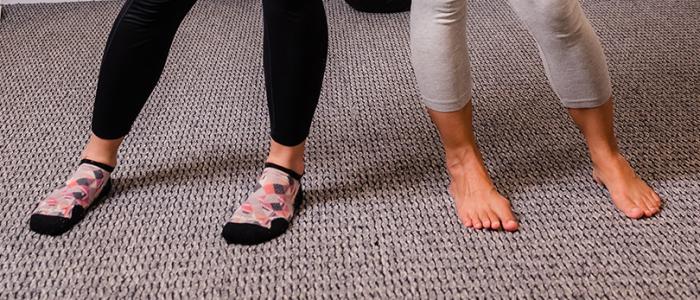
Achilles tendinopathy
Achilles tendinopathy is an irritation of the Achilles tendon. Achilles tendon pain is one of the most common types of pain felt behind the heel and up the back of the ankle when walking or running. Although Achilles tendinopathy affects both active and inactive individuals around half of runners will experience Achilles tendon pain in their running careers, so it is a concern for many runners in the Washington, DC area. Achilles tendinopathy can result in a limited ability to walk, climb stairs, or participate in recreational activities. Rose physical therapists are uniquely qualified to help reduce pain in the Achilles area, and restore strength, flexibility, and mobility to the injured tendon and eliminate swelling when present.
At Rose, our team of physical therapists are uniquely qualified in many advanced diagnostic and treatment procedures like McKenzie MDT, Maitland, Graston, Active Release Techniques (ART), and trigger point dry needling. These advanced skills are unique to Rose physical therapists because most therapists at Rose possess multiple certifications in these advanced skills, allowing us to use multiple modalities to diagnose and treat you as effectively as possible. This also allows Rose physical therapists in Washington, DC to look at the whole kinetic chain of events leading to your achilles pain and really figure out and make an impact on your return to normal function.
What is Achilles Tendinopathy?
Achilles tendinopathy is an irritation of the Achilles tendon, a thick band of tissue along the back of the lower leg that connects the calf muscles to the heel. The term “tendinopathy” refers to any problem with a tendon, either short- or long-term. The Achilles tendon transmits force from the calf muscles down to the foot when a person pushes the foot off the ground (eg, runs or jumps), and helps control the position of the ankle when the foot touches back down on the ground (eg, lands). Achilles tendinopathy results when the demand placed on the Achilles tendon is greater than its ability to function. The condition can occur after a single incident (acute injury) or after repetitive irritation or "microtrauma" (chronic injury). Most often, Achilles tendon pain is the result of repetitive trauma to the tendon that can result in chronic Achilles tendinopathy—a gradual breakdown of the tissue—and is most often treated with physical therapy.
Achilles tendinopathy is linked to several different factors, including:
- Calf muscle tightness
- Calf muscle weakness
- Abnormal foot structure
- Abnormal foot mechanics
- Improper footwear
- A change in an exercise routine or sport activity
Pain can be present at any point along the tendon; the most common area to feel tenderness is just above the heel (known as midportion Achilles tendinopathy), although it may also be present where the tendon meets the heel (known as insertional Achilles tendinopathy).
How Does It Feel?
With Achilles tendinopathy, you may experience:
- Tenderness in the heel or higher up in the Achilles tendon with manually applied pressure
- Pain and stiffness with walking, at its worst with the first several steps
- Tightness in the calf
- Swelling in the back of the ankle
How Is It Diagnosed?
A Rose physical therapist will review your medical history and complete a thorough examination of your heel, ankle, and calf, including assessment of your foot posture, strength, flexibility, and movement. This process may include watching you stand in a relaxed stance, walk, squat, step onto a stair, or do a heel raise. The motion and strength in other parts of your leg also will be assessed.
A Rose physical therapist may also ask questions regarding your daily activities, exercise regimens, and footwear, to identify other contributing factors to your condition.
How will your physical therapist at Rose Physical Therapy help?
Physical therapy promotes recovery from Achilles tendinopathy by addressing issues such as pain or swelling of the affected area, and any lack of strength, flexibility, or body control. You and your Rose physical therapist will work together to develop an individualized treatment program to help you achieve your specific goals in the safest and most effective way possible. Your treatment may include:
Education. A Rose physical therapist will work with you to identify any possible external factors causing your pain, such as faulty footwear or inappropriate movements or exercises, and including assessment of your footwear and recommend improvements, and develop a personalized exercise program to help ensure a pain-free return to your desired activities.
Pain management. Many pain-relief strategies may be implemented, such as applying ice to the area, putting the affected leg in a brace, using heel lifts, or using therapies such as iontophoresis (a medicated patch placed on the skin that is electrically charged and used to decrease pain and inflammation), or therapeutic ultrasound. These strategies can reduce the need for pain medication, including opioids.
Manual therapy. Your Rose physical therapist may apply hands-on treatments to gently move your muscles and joints in order to improve their motion and function. These techniques often address areas that are difficult to treat on your own.
Range-of-motion treatments. Your ankle, foot, or knee joint may be moving improperly, causing increased strain on the Achilles tendon. Self-stretching and manual therapy techniques (massage and movement) applied to the lower body to help restore and normalize motion in the foot, ankle, knee, and hip can decrease this tension and restore full range of motion.
Gentle exercise. Loading of the tendon (applying weight or resistance to it) through exercise can be beneficial for recovery from Achilles tendinopathy. You may begin by performing gentle strengthening exercises in a seated position (eg, pushing and pulling on a resistive band with your foot). You then may advance to exercises in a standing position (eg, standing heel raises).
Muscle-strengthening exercises. Muscle weakness or imbalance can result in excessive strain on the Achilles tendon. Based on your specific condition, your physical therapist at Rose will design an individualized, progressive, lower-extremity resistance program for you to help correct any weakness-associated movement errors that may be contributing to your pain.
Functional training. Once your pain eases and your strength and motion improve, you will need to safely transition back into more demanding activities. To minimize the tension placed on the Achilles tendon and your risk of repeated injury, it is important to teach your body safe, controlled movements. Based on your goals and movement assessment, your Rose physical therapist will create a series of activities that will help you learn how to use and move your body correctly to safely perform the tasks required to achieve your goals.
If additional interventions are needed, such as injections, minimally invasive tendon procedures, or surgery, your physical therapist will work with you before and after your procedure to help you regain motion, strength, and function. We have been in business for a long time by Washington, DC standards, and we have many connections and a great knowledgebase of who can be the right fit for you in the National Capitol Metro Region in the event that we need to refer out for more help.
Something that will always set Rose Physical Therapy apart is that we will not just do endless exercises with no improvement. At Rose, we work to get to the bottom of an issue as quickly as possible, and we're not afraid to refer out to physicians if we think it can help you recover faster and effectively. Our goal is only to get you better, so give us a call if you are experiencing problems with your Achilles, or schedule through our website.


